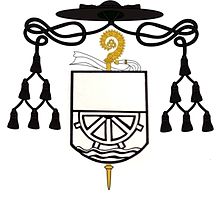Nicholas III Molitor
Nicholas III Molitor (* 1600 in Geldersheim ; † December 10, 1640 ) was abbot of the Benedictine monastery in Münsterschwarzach from October 1640 until his death in December .
Münsterschwarzach before Molitor
The most important predecessor of Abbot Nikolaus Molitor was Johannes IV. Burckhardt in the middle of the 16th century . He promoted the monastic discipline that had suffered from his predecessors. At the same time he expanded the area that the abbey directly ruled, so that a total of seven villages were subordinated to the monastery. The abbot also pushed ahead with debt relief. He also took part in the re-catholicization in the diocese of Würzburg .
Burckhardt's successors continued his policy. John VI Martin had the abbey upgraded because the Thirty Years War broke out during his tenure . During his reign the monastery began to decline, as it could no longer till its fields during the war and the Little Ice Age. In 1631 the monastery was occupied by the Protestant Swedes and the convent had to flee to Würzburg . It was not until 1636 that the monks could return to the dilapidated buildings.
Life
Nicholas III Molitor was born in the year 1600 in Geldersheim, Lower Franconia, near the free imperial city of Schweinfurt . Nothing is known about his family and parents, and the sources are silent about the early education of the young Nicholas. It was only when he began studying rhetoric that Geyer became tangible again. Around 1622 he entered the Münsterschwarzach Abbey and made his vows there in 1623 .
He quickly received his ordination levels. On September 21, 1624 he received the minor ordination , Geyer became subdeacon on September 23, 1628. Almost a year later, on March 10, 1629, he became a deacon , before receiving the priesthood on April 14, 1629. The young monk had previously left the abbey to continue studying at the University of Würzburg . He matriculated there in 1627, probably to intensify his theological studies.
The first office within the monastery was that of prior . Konrad Geyer gained insight into the monastery administration from 1630 to 1631, before his ascent was suddenly interrupted by the capture of the monastery. The prior then accompanied his abbot Johannes Kassian Speiser into exile in Würzburg and later in Tyrol . He did not return to the destroyed complex until May 6, 1637 to check the condition of the buildings for his abbot.
Geyer was again appointed prior on November 3, 1637. Two years later, on June 26, 1639, he was appointed pastor in the monastery village of Sommerach . Here he was pastorally active until his election. When Abbot Johannes Kassian died in the middle of 1640 an election was necessary. This took place on the feast of St. Burkard , October 11, 1640. Due to the small strength of the convent, only five monks elected the head.
Nikolaus Molitor, who was already ill, emerged as the winner of the election. On November 20, 1640, he received his confirmation before it on December 2, 1640 benediziert could be. Only eight days after his ordination, Abbot Nicholas III died on December 10, 1640 at around eight o'clock in the morning. In his honor a tomb was erected in the monastery church, which with a Latin inscription praised the few deeds of Nicholas.
coat of arms
Due to the very short reign of the abbot, Nikolaus Molitor's personal coat of arms was only preserved on a seal of his successor Silvanus Speht , which he added to the letter to the Würzburg prince-bishop in 1641. The upper part of this seal, however, is unrecognizable. Therefore the description of the coat of arms is incomplete, especially since information about the colors is missing. Description: Shared; Above no description possible, below over shafts an eight-spoke mill wheel below.
literature
- Kassius Hallinger: Chronology of the abbots of Münsterschwarzach a. M. (1390-1803). In: Abtei Münsterschwarzach (Ed.): Abtei Münsterschwarzach. Works from their history . Münsterschwarzach 1938.
- Rainer Kengel: The coat of arms of the abbots of Münsterschwarzach. In: Abtei Münsterschwarzach (Ed.): Abtei Münsterschwarzach. Works from their history . Münsterschwarzach 1938.
- Johannes Mahr: Münsterschwarzach. 1200 years of a Franconian abbey . Münsterschwarzach 2002.
Individual evidence
- ↑ Johannes Mahr: Münsterschwarzach - 1200 years of a Franconian abbey . 1st edition. Vier-Türme Verlag, Münsterschwarzach / Abtei 2002, ISBN 3-87868-174-7 , p. 30 .
- ↑ Kassius Hallinger: The chronology of the abbots of Münsterschwarzach. P. 108.
- ↑ Kassius Hallinger: The chronology of the abbots of Münsterschwarzach. P. 109.
- ↑ Rainer Kengel: The coat of arms of the abbots of Münsterschwarzach. P. 147.
| predecessor | Office | successor |
|---|---|---|
| Johannes Kassian Speiser |
Abbot of Münsterschwarzach 1640 |
Silvanus spies |
| personal data | |
|---|---|
| SURNAME | Molitor, Nicholas III. |
| BRIEF DESCRIPTION | German Benedictine abbot |
| DATE OF BIRTH | 1600 |
| PLACE OF BIRTH | Geldersheim |
| DATE OF DEATH | December 10, 1640 |
